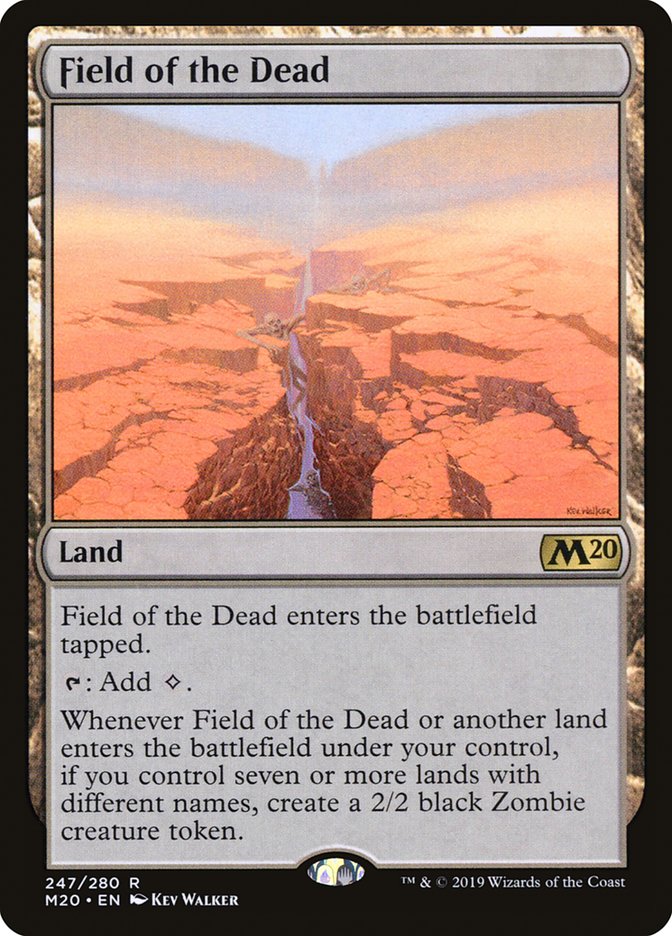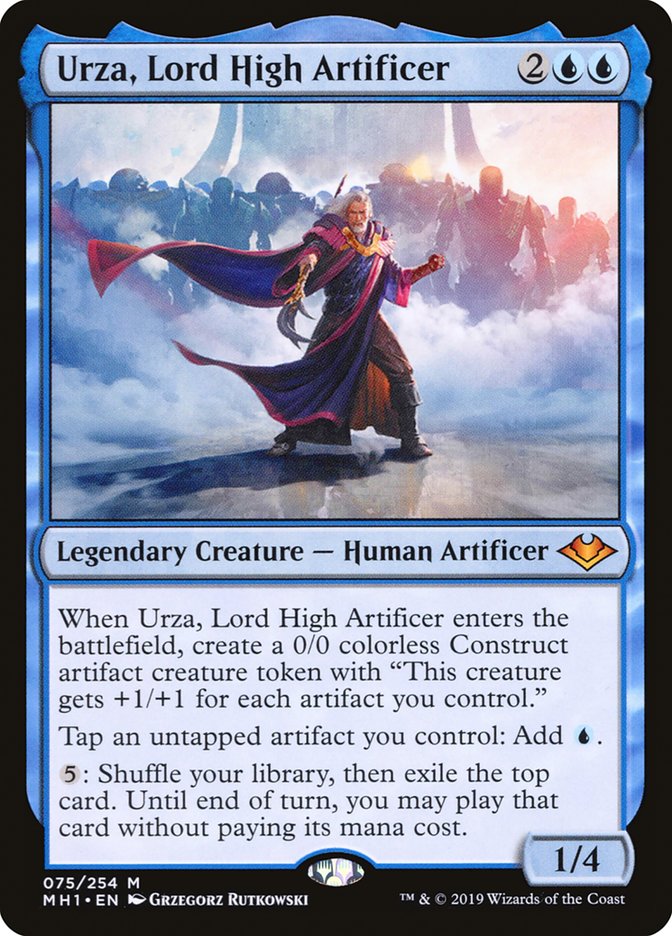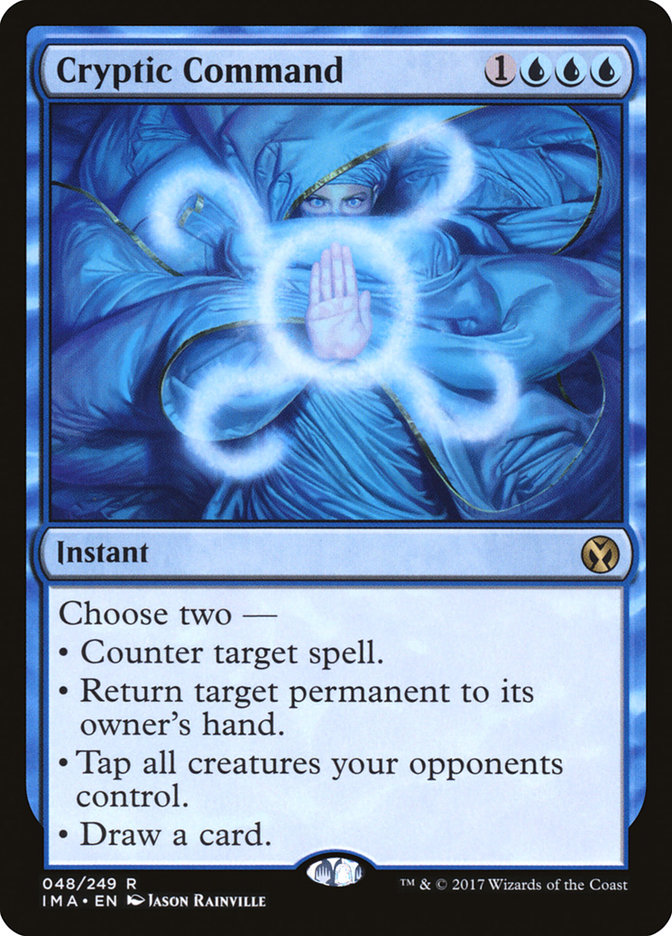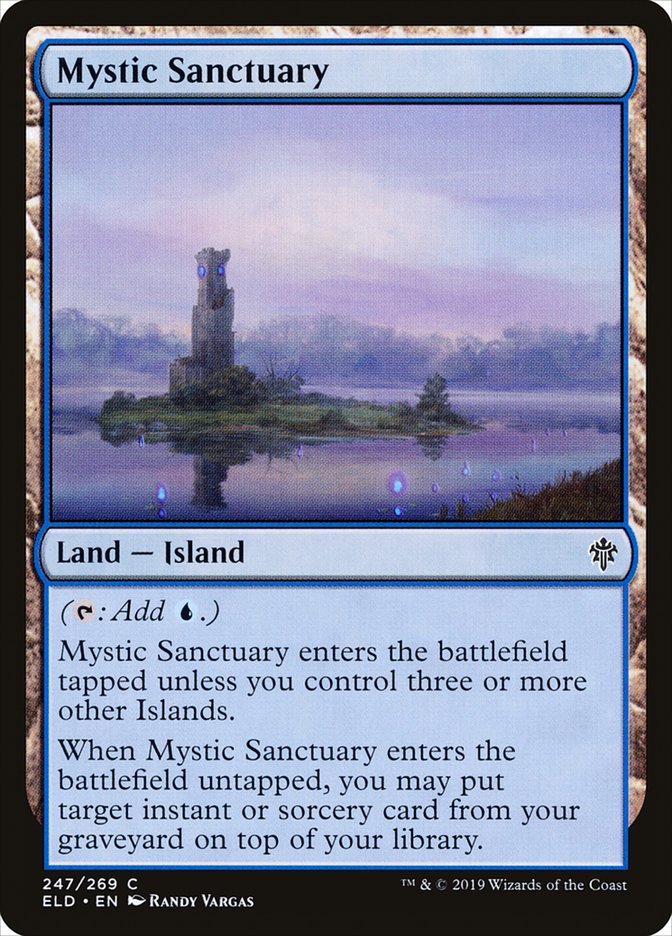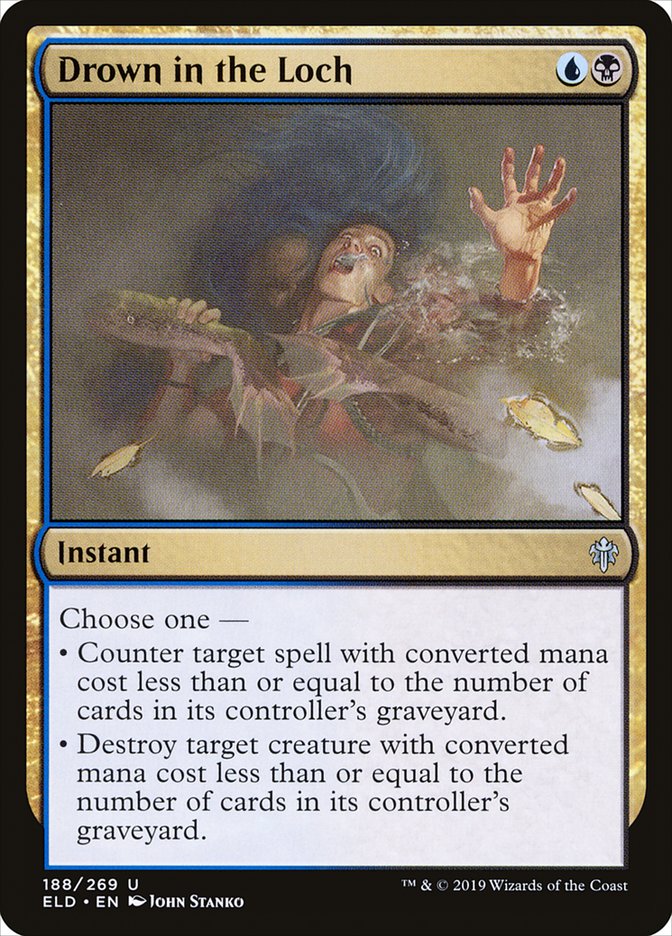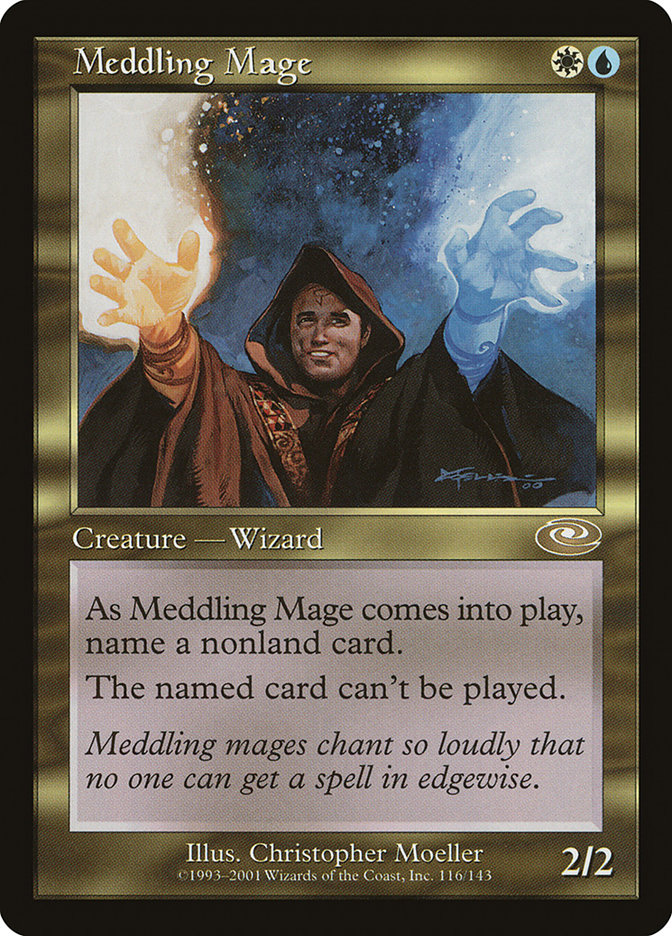Modern is almost always far too diverse for any single deck to make up a significant portion of the metagame. As a result, it tends to be useful to consider clusters of related archetypes rather than individual decks. When considering a deck’s positioning for a given weekend, I tend to think about how it matches up against fast combo or Thoughtseize decks rather than specifically Gifts Storm or Jund. You simply won’t face even the most popular deck more than twice a tournament, so it’s critical to not overprioritize individual decks in your analysis.
Since the printing of Throne of Eldraine, Modern has been dominated by two archetype clusters: Ramp decks and Urza, High Lord Artificer decks. According to the metagame breakdown from SCG Indianapolis, ramp decks put a whopping 27 copies into Day 2 while Urza decks were not far behind with 25.
Each of these clusters contains precisely three sub-archetypes, which do have some important differences. But the clusters can overall be exploited in predictable ways, and right now any deck that can do so and is favored against both is a prime candidate for success.
The Ramp Cluster
Creatures (13)
Lands (27)
Spells (20)

Creatures (8)
- 3 Wurmcoil Engine
- 2 Thragtusk
- 1 Ulamog, the Ceaseless Hunger
- 1 Emrakul, the Promised End
- 1 Walking Ballista
Planeswalkers (8)
Lands (17)
Spells (27)

Creatures (8)
Planeswalkers (1)
Lands (25)
Spells (26)

Amulet Titan, Mono-Green Tron, and TitanShift are the most successful ramp variants right now. All of them use crucial nonbasic lands to take game-ending actions far ahead of schedule. All of them are light on interaction and generally plan to ignore and trump the opponent’s gameplan rather than interact directly. In fact, the only purely interactive spells in any of the maindecks are a couple of Lightning Bolts and a tutorable Engineered Explosives. Most spot removal is fairly inconsequential against these decks, although Fatal Push can be a useful speed bump against Amulet Titan and Path to Exile can be relevant in concert with other interaction.
Ramp decks have been so successful lately for two major reasons. First, Once Upon a Time combined with the London mulligan has pushed the consistency of Mono-Green Tron and Amulet Titan to the point where they have almost no fail rate. Gone are the days of loose Mono-Green Tron keeps never coming together and Amulet Titan producing six mana on Turn 3 but never finding a Primeval Titan.
The second major reason is Field of the Dead, a card that recently had the dubious honor of breaking Standard.
Field of the Dead means that Primeval Titan decks have an incredible backup plan with nearly no investment. Gone are the days when answering that first Titan would buy a fair deck time to execute its plan. These days, if a Titan trigger resolves, most fair decks will need to expend a huge amount of resources to clean things up. It’s possible to answer the Titan, the Field of the Dead, and the two Zombie tokens, but it is a disgusting number of cards.
The Urza Cluster
Creatures (9)
Planeswalkers (2)
Lands (18)
Spells (31)

Creatures (9)
Planeswalkers (2)
Lands (18)
Spells (31)

Creatures (7)
Lands (20)
Spells (33)

Urza decks all seek to assemble an elaborate and easy-to-disrupt combo involving its namesake card, backed up a rock-solid fair game. Urza decks lean hard on their combos against unfair decks and try to grind out fair decks. That said, each variant tends to execute the respective plans at different rates. Traditional Whirza decks tend to be the best at playing fair games, but the worst at ending the game with their combo. Urza Ascendancy decks are the fastest and most powerful, but the worst at playing legitimate Magic, and Urza Outcome occupies a nice middle ground.
All variants of the deck ignore artifact removal. They’re good at recurring artifacts and most individual ones are not important to their plans. They are inconvenienced, but not crippled, by Stony Silence effects. They mess with their mana and blank cards like Thopter Foundry and Mishra’s Bauble, but are far from game-ending. Creature removal is good here, as all variants have at least seven good targets, often more. But the removal needs to be usable on the early turns while hitting Urza later in the game. Fatal Push and Drown in the Loch are great, Path and Lightning Bolt less so.
These decks have been succeeding as of late because Urza is a completely ludicrous Magic card that probably should not exist. It doesn’t hurt that it’s paired with Mox Opal, the strongest mana acceleration in Modern, and Arcum’s Astrolabe, the best non-land mana fixing ever printed.
Exploit One: Be Fast
Neither of the two major clusters of decks has much in the way of interaction. They’re highly resilient, but they’re not incredibly fast. They usually take a relevant game action for the first time on the third or fourth turn, and often that action will not immediately end the game. Even Urza Ascendancy, the fastest of the six decks, needs a fairly specific combination of cards to end the game before Turn 4.
As a result, any deck that kills on Turn 3 regularly and Turn 4 consistently will do well in this sort of metagame. One way to accomplish this is the Gifts Storm list that allowed Drake Sasser to hoist the trophy in Indianapolis.
Creatures (8)
Lands (18)
Spells (34)
- 2 Sleight of Hand
- 4 Serum Visions
- 4 Gifts Ungiven
- 4 Desperate Ritual
- 3 Merchant Scroll
- 1 Echoing Truth
- 2 Opt
- 2 Remand
- 2 Grapeshot
- 4 Manamorphose
- 4 Pyretic Ritual
- 2 Past in Flames
Sideboard

But that’s far from the only approach. For the first time in ages, Infect actually looks reasonably positioned. Infect can use Once Upon a Time to increase its number of keepable hands. It can race Engineered Explosives and easily fight through the small amounts of removal Urza decks pack in their sideboards. It can also sideboard in Collector Ouphe to prevent fast Emry kills and Engineered Explosives.
Neobrand is another option in the realm of fast, uninteractive combo. While it’s never beaten a Force of Negation in the history of Magic, it lines up pretty well against Emry and Urza’s Tower. Devoted Devastation is also an option to goldfish these decks out of the format. It’s horrible against consecutive spot removal spells, but people just aren’t bringing those in large numbers at the moment.
Creatures (22)
- 2 Birds of Paradise
- 4 Devoted Druid
- 4 Noble Hierarch
- 1 Walking Ballista
- 4 Vizier of Remedies
- 2 Shalai, Voice of Plenty
- 4 Giver of Runes
- 1 Ranger-Captain of Eos
Lands (19)
Spells (19)

Exploit Two: Huge Amounts of Countermagic
The Urza decks are not vulnerable to the traditional formula of “interaction plus clock.” All their threats matter and cards like Sai, Master Thopterist and Engineered Explosives are great at answering a small number of threats and buying time. What they are vulnerable to is simply having every one of their threats countered up the curve. If your opponent is only going to cast an Emry, an Urza, and a Sai or Thopter Foundry in the first few turns, countering all of them becomes eminently reasonable. By the same token, Mono-Green Tron can out-topdeck and power through small numbers of counterspells but has a lot of trouble with a critical mass of them.
Any deck executing this plan is sure to capitalize on large numbers of Mystic Sanctuary and Cryptic Command meaning that it will never run out of counterspells and is frequently capable of cleaning up the single uncounterable threat that Amulet Titan and Mono-Green Tron often produce. Decks taking this route need to be able to answer lands to reliably beat Field of the Dead out of the Primeval Titan decks. This can take the form of Assassin’s Trophy, as seen in Sam Black Mystic Sultai deck, or Field of Ruin in more traditional Azorius Control decks. Sam’s deck also has the notable upside of getting to play Drown in the Loch, which removes resolved Emry and Goblin Engineer while being an actively good card against the ramp cluster.
Creatures (5)
Lands (23)
Spells (32)

Creatures (3)
Planeswalkers (7)
Lands (25)
Spells (25)

Exploit Three: Meddling Mage
Everyone seems to have forgotten that Humans existed. But before the printing of Wrenn and Six, Humans was the best deck in Modern. Any time that card flags in popularity, Humans is poised to return to its former glory. I know there was a decent amount of Jund on Day 1 of Indianapolis, but frankly I think Jund is unfavored versus both ramp and Urza decks, so I don’t expect it to remain popular.
The reason Meddling Mage is so strong right now is that Urza has only a single piece of interaction in its maindeck: Engineered Explosives. If you Meddling Mage Explosives or land a Collector Ouphe, all your creatures are safe forever. That gives you ample time to utilize Kitsesail Freebooter; Thalia, Guardian of Thraben; and additional Meddling Mages to demolish their primary gameplan. It’s also nice that Reflector Mage lines up well against Emry, Lurker of the Loch and cleanly answers Urza’s Construct token. After sideboard, you also gain access to Kambal, Consul of Allocation and Gaddock Teeg, meaning that you’re almost certain to be able to stop their combo once your team is protected from Explosives.
The other incredibly appealing thing about Meddling Mage right now is naming Primeval Titan against Amulet Titan and TitanShift. In the past, Amulet Titan played a bunch of one-of threats to get it out of tough spots. But these days, all of its flex slots are spent on cantrips, which means that if they can’t Titan, they can’t do much. They get to sideboard up to a large number of Engineered Explosives, but Humans gets to sideboard in Collector Ouphe and Gaddock Teeg to once again re-trump.
Humans can sometimes struggle with specifically Mono-Green Tron, but between Collector Ouphe, Gaddock Teeg, and a couple of Damping Spheres, I think the matchup is very winnable. Damping Sphere also doubles as bounceland hate against Amulet Titan and a lock piece against Urza, making it incredibly well-positioned right now. I recommend playing a couple if you’re playing almost any deck that can ignore it.
Creatures (38)
- 4 Meddling Mage
- 4 Noble Hierarch
- 3 Phantasmal Image
- 4 Champion of the Parish
- 4 Thalia, Guardian of Thraben
- 1 Kessig Malcontents
- 4 Mantis Rider
- 4 Reflector Mage
- 4 Thalia's Lieutenant
- 3 Kitesail Freebooter
- 3 Charming Prince
Lands (18)
Spells (4)

The way to win in Modern right now is to tend towards extremes. Pick the thing your deck does and do that thing as hard as you possibly can. It’s a tough time to be a midrange deck, but a great time to be either completely ignoring your opponent or answering literally every threat they present. But personally, I’m somewhat excited to re-sleeve Champion of the Parish for my next Modern event. It’s about time.


